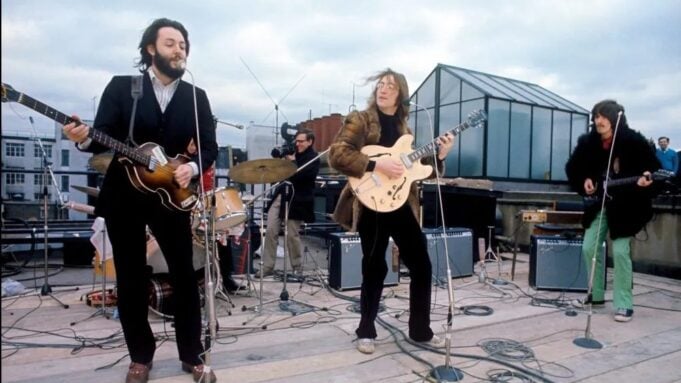I first saw “Let It Be” when I was a kid, in the summer of 1970, just weeks after it was released. My family was coming off one of those “Vacation” road trips. During the miles of driving, we listened to Top 40 radio, which meant that several times a day I got to hear “The Long and Winding Road,” which I thought was the most beautiful song I’d ever heard. (To this day, I adore the Phil Spector heavenly-choir orchestral-layer-cake version and have never understood Paul McCartney’s aversion to it.) I knew that the first thing I was going to do when we got back was go to see “Let It Be” — and, in fact, it was the first Beatles thing I was old enough to connect to as it was happening.
The Beatles, in their early years, looked alike (same hair and suits, same lemon-shaped smiles), and even after they’d entered the psychedelic zone with “Revolver” and “Sgt. Pepper” they dressed and coiffed themselves with a splashy coordinated harmony. They were unified. And that made a kind of supreme sense, since they were the larger-than-life pop avatars of love. They sang about love and made a mantra of it; love was the centrifugal force that held their music together. But “Let It Be,” starting with that plaintive shrug of a title (which seemed to be telling a planet’s worth of fans that the dream was over), had a very different vibe.
Shot in 16mm-transferred-to-35mm, Michael Lindsay-Hogg’s inside-the-recording-studio documentary was short and sweet (only 81 minutes long), but it was also dark, grainy, and desultory. The film caught the Beatles in several moments of tension (notably a tiff between Paul and George), but even when they were grooving together they appeared separate. They no longer looked alike (they seemed to be going to four different hippie hairdressers — or, in the case of John Lennon, none at all). The songs were rough and jagged. The Beatles weren’t shaggy lads anymore, they were men. And in their disparate grownup identities, they seemed to embody something about how the entire culture was fragmenting at the seams.
“Let It Be” ripped the mask of mythology off the Beatles. Arriving just a month after the group’s official breakup, the movie seemed to be telling a grand story of dissolution. In “A Hard Day’s Night,” the four of them had been like gods at play. And yes, they recorded the seamless and sublime “Abbey Road” after the raw and unfinished “Let It Be.” Yet in “Let It Be,” the faces of the Beatles now loomed up on screen as if they were ex-gods starring in the first rock ‘n’ roll reality show.
That, however, was then. When Peter Jackson plunged back into the 57 hours of footage that Michael Lindsay-Hogg shot for “Let It Be” and assembled it into “The Beatles: Get Back” (2021), his extraordinary eight-hour documentary, Jackson’s expanded epic revealed that the fabled January 1969 recording sessions were not the downer of legend. There were many moments that were funny, spirited, communal. That said, what of the original “Let It Be”? After the revelation of “Get Back,” would it still look like the morning-after hangover of the Beatles’ saga?
The film has been out of circulation since the 1980s. It is now being re-released by Disney+ in a version restored by Jackson’s team, using the same technological wizardry that made “Get Back” look and sound like a present-tense epiphany. The restoration allows “Let It Be” to be sharper, brighter, more alive, without betraying the original film. The early scenes shot in Twickenham Studios still give off that tinge of gloom. But only a tinge.
For me, though, the revelation of seeing “Let It Be” today, when everything about the Beatles is now ancient history, is that as you experience the movie anew (or for the very first time), it’s not the myth of the Beatles that falls away. It’s the myth of “Let It Be.” I now think it’s one of the most joyful rock documentaries ever made.
Love Film & TV?
Get your daily dose of everything happening in music, film and TV in Australia and abroad.
What’s changed? It’s not merely the Jackson upgrade. It’s that the Beatles, viewed with half a century’s hindsight, no longer look so separate. Their identities remain separate — by this point, they were locked into their own lives as complicated adults — but what we now see, knowing all that in our bones, is the lingering, between-the-lines emotional profundity of the connection between them. We now feel how the music, every gloriously ragged note of it, arises out of their love for each other.
The movie has moments that entrance you, that make you swoon, that lift you into rock heaven. Like John dancing a waltz with Yoko to the lilting electric melancholy of “I Me Mine” (Yoko, throughout, looks so serenely supportive and engaged that the idea that she was an intrusive presence now seems nuts). Or the blissful fervor with which the Beatles lay into old chestnuts like “Shake, Rattle and Roll” (they still relish their past). Or the way “Two of Us” evolves from a wobbly ditty into a transcendent ode to brotherly love. Or the double dose of crackling confessional romantic vibrance, from John and Paul, of “Dig a Pony” and “I’ve Got a Feeling.” Or Paul, more soulfully handsome than anyone in rock, doing his indelible gazing-into-the-camera rendition of the title track. Or the way the final rooftop concert, and the London bobbies’ attempt to shut it down, plays as a compressed 15-minute parody of the entire counterculture ’60s — the hippies vs. the squares, except that in the Beatles’ version there are no bad guys. The message of “Let It Be” is that even if you are separate, you can come together.
From Variety US































